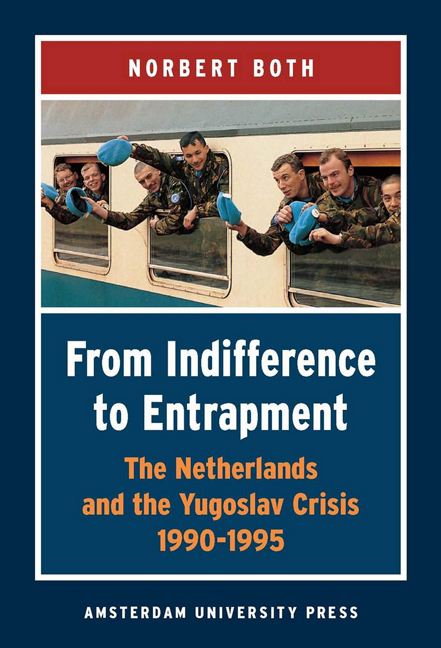Book contents
- Frontmatter
- Dedication
- Contents
- Preface
- Abbreviations
- Chronology
- Introduction
- 1 The Netherlands and its Foreign Policy System
- 2 An Emerging Challenge, July 1990 - June 1991
- 3 From ‘Even-Handedness’ to ‘Selectiveness’, July -December 1991
- 4 Moral and Political Entrapment: The Netherlands and International Peace Plans for Bosnia, 1992-1994
- 5 Military Entrapment: The Commitment to Srebrenica
- Conclusion
- Bibliography
- Index of Names
5 - Military Entrapment: The Commitment to Srebrenica
Published online by Cambridge University Press: 14 January 2021
- Frontmatter
- Dedication
- Contents
- Preface
- Abbreviations
- Chronology
- Introduction
- 1 The Netherlands and its Foreign Policy System
- 2 An Emerging Challenge, July 1990 - June 1991
- 3 From ‘Even-Handedness’ to ‘Selectiveness’, July -December 1991
- 4 Moral and Political Entrapment: The Netherlands and International Peace Plans for Bosnia, 1992-1994
- 5 Military Entrapment: The Commitment to Srebrenica
- Conclusion
- Bibliography
- Index of Names
Summary
On July 11, 1995, the safe area of Srebrenica was taken by (Bosnian) Serb forces. In the immediate aftermath the Serbs killed over seventhousand Muslim men. The great majority of these men were not killed in battle but murdered after having been taken prisoner. It had taken the Serbs a week to conquer and ethnically cleanse the safe area and it had proved to be a relatively easy task. There had been little resistance from the fourthousand Muslim soldiers in the enclave, the fourhundred Dutch peacekeepers deployed there, or from UNPROFOR as a whole.
Dutch military entrapment in the Bosnian conflict began on June 22, 1993, became concrete in February 1994 and was completed in February 1995. On June 22, 1993, the Dutch government committed itself internationally to an additional military contribution for the specific purpose of implementing the UN Security Council's safe area policy. In February 1994, the first Dutch troop contingent entered the Srebrenica enclave as hostages to their environment. One year later, the Bosnian Serb army stopped all but the most essential goods from entering the enclave of Srebrenica, thereby fully shutting the trap. As became painfully evident, the trap could not be reopened from within nor from outside.
In retrospect it would, perhaps, have been better for everyone had the Dutch government refused to go to Srebrenica – at least at this stage. This much was suggested by the very UNPROFOR commander who eventually assigned the Srebrenica mission to the Dutch troops, Belgian Lt. General Francis Briquemont. ‘In November 1993 all countries refused to deploy troops in Srebrenica … I then informed both supreme Commander Cot and the UN authorities that I thought about giving up Srebrenica. The answer from New York came quickly: “Impossible. Do something, general.” At that point, after all, the Dutch accepted the mission. But given that by late 1993 I was facing increasingly difficult negotiations with the Serb commander Mladic, perhaps I should have stuck to my original position… If the Dutch government had taken on the same attitude as many other states, a deep crisis would have erupted between the military command of UNPROFOR and the UN leadership. Such a crisis might have been salutary.’
- Type
- Chapter
- Information
- From Indifference to EntrapmentThe Netherlands and the Yugoslav Crisis, 1990–1995, pp. 181 - 224Publisher: Amsterdam University PressPrint publication year: 2012



